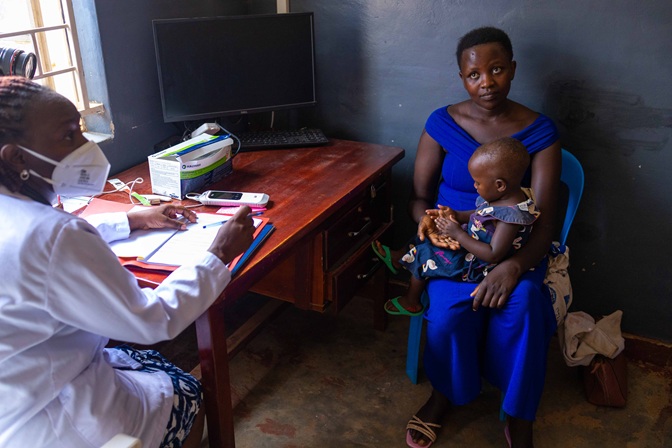Diagnosis of tuberculosis in children
TB-ALGORIT-PED: Diagnostic performance and feasibility of two new treatment decision algorithms for pulmonary tuberculosis in children
Background
Under diagnosis and subsequent under treatment of tuberculosis (TB) in children is a major public health issue in many parts of the world. To provide more structured guidance to primary health care staff assessing children with presumptive TB, the World Health Organization has recently recommended the use of two integrated treatment decision algorithms (for contexts with and without radiography). These algorithms allocate evidence-based scores to clinical and radiological features to allow clinicians to make decisions regarding the initiation of TB treatment in children in children < 10 years of age with presumptive pulmonary TB. The WHO recommendation was formulated as an interim, conditional recommendation and the WHO has called for the generation of evidence through external validation and other studies, to inform a future review of the recommendation on the diagnosis, management of TB in children.
Aim of the study and objectives
The overall aim of the study is to evaluate the diagnostic performance, describe the diagnostic cascade and assess the feasibility of implementing the new 2022 WHO treatment decision algorithms for pulmonary TB in children under 10 years old under programmatic conditions.
The study had several secondary objectives related to the use of the algorithms but also to assess the added value of TB-LAM in HIV-negative children and of Point-of-care ultrasound (POCUS) for the diagnosis of TB in children.
This program is one of 3 pillars the TACTiC project – Test, Avoid, Cure Tuberculosis in Children – a multifaceted project led by Médecins Sans Frontières (MSF). Its goal: to reduce deaths from tuberculosis in children, by increasing the number of children put on treatment and preventive treatment.
Primary objectives
- To assess the diagnostic accuracy of the 2022 WHO treatment decision algorithms against a reference standard.
- To document the diagnostic cascade using the 2022 WHO algorithms (frequency of children undergoing each step of the algorithms, started on TB treatment etc).
To assess health workers and patients/caregivers’ perspectives on the 2022 WHO treatment algorithms including challenges and enablers to the introduction of the recommended algorithms.
Secondary objectives
- To assess clinical evolution, TB treatment initiation, and mortality at 2 months of follow-up.
- To assess the diagnostic performance of TB-LAM in HIV-positive and HIV-negative children (only specific study sites).
- To assess the diagnostic performance of POCUS (only specific study sites).
- To compare the actual TB treatment algorithms’ recommendations with the potential recommendation that would have been reached if chest X-ray or laboratory results were not available.
- To assess the number and the proportion of children potentially eligible for a 4-month treatment regimen.
- To report changes on paediatric aggregated case notification rates 12 months prior to, and 12 months following the implementation of the algorithms.
Countries
Nigeria, Niger, Guinea, Uganda, South Sudan
Status
Analysis of results in progress
Tentative end Date
December 2025
Epicentre role
Study Coordination
Partners
Médecins Sans Frontières France, Médecins Sans Frontières Belgium, Médecins Sans Frontières Spain, Ministry of Health, Nigeria, Ministry of Health, Niger, Ministry of Health, Guinea, Ministry of Health, Uganda, Ministry of Health, South Sudan, University of Tübingen, Germany, ANRS, France
Methods
Performance of the algorithms (accuracy and cascade of care)
An observational prospective diagnostic multi-country study will be conducted to assess the diagnostic performance (accuracy and cascade) of the 2022 WHO treatment decision algorithm. Children included in the study will be followed up to two months after the initial algorithm assessment. Study sites and countries will be: Niger (Madarounfa), Nigeria (Maiduguri), Guinea (Conakry), South Sudan (Malakal), and Uganda (Mbarara).
Children presenting with signs or symptoms suggestive of pulmonary TB (presumptive pulmonary TB), age less than 10 years and whose representative provided informed consent will be invited to participate. Depending on the study site, the algorithms with or without chest X-ray will be assessed on either ambulatory and/or hospitalized children.
Some sites will only include malnourished children (Niger and Nigeria) or children living with HIV (Guinea). Participants will be included for a minimum of 6 months. The inclusion period is expected to last 6 to 12 months, aiming for a sample size of minimum 500 in Uganda, 230 in South Sudan, 600 in Niger, 350 in Nigeria, and 340 children in Guinea.
Process evaluation (documentation, feasibility and acceptability study)
In all five countries, the research team will document how the new 2022 WHO algorithms are implemented. The researchers will describe in detail each step of the intervention from the delivery of the training to the patient’s discharge. This will allow to highlight needs, priorities and challenges encountered when using the new TB algorithm across different countries.
A mixed-methods multi-country study will be conducted in three study sites (Niger, Guinea, and Uganda) to assess the process of the intervention, including the feasibility of implementing the 2022 WHO algorithm and the health care workers and patients/caregivers’ perspectives on it.
Caregivers of children with presumptive TB or with TB, key informants working/living with children with TB, health managers, policy makers and health workers 18 years and above will be purposively chosen. Data will be collected through in-depth and semi-structured interviews, focus groups discussions, health workers’ diaries and non-participant observations.
The process evaluation will follow the Medical Research Council (MRC)’s process evaluation framework adapted in 2010 for complex interventions. It will be conducted in three phases: (1) Before implementing the algorithms to analyse the contextual factors that may influence their implementation; (2) During training and within 6 months of implementation to analyse the impact mechanisms of the implementation, how the new practice of algorithmic diagnosis is perceived and implemented; (3) Within 12 months post implementation to analyse the impact mechanisms of the implementation over time.
Discover the key findings of the TB-ALGO-PED study, presented at the World Conference on Lung Health (November 18–21, 2025).
The study reveales that using the therapeutic decision algorithms recommended by the World Health Organization (WHO) to diagnose tuberculosis in children could almost double the number of children receiving anti-tuberculosis treatment.
Explore the posters shared during the conference below.
Increase in TB diagnosis among children after implementing new WHO treatment decision algorithms in 5 sub-Saharan African countries
Diagnostic accuracy of new treatment decision algorithms for TB in children: a multi-country diagnostic study
Treatment decision algorithms to detect pediatric pulmonary tuberculosis in unstable settings: Experience in South Sudan
Words Matter: Caregiver-health worker communication when using paediatric TB treatment decision algorithms
Can we diagnose TB better in nutrition centers? Experience from Maiduguri, Nigeria
Finding TB in children living with HIV: Results using the WHO-recommended algorithms in Conakry, Guinea
Improving the diagnosis of tuberculosis among children with malnutrition in Niger, Nigeria and South Sudan
Point-of-care ultrasound to support the new WHO treatment decision algorithms in the diagnosis of TB in children
This study will contribute to a larger pool of evidence allowing the evaluation of the WHO recommended treatment decision algorithms. The study results will be shared with the WHO to support the revision of their algorithms. This will ensure that the results contribute to build the future WHO recommendations.















